Rinodina guzzinii Jatta
N. Giorn. Bot. Ital., 23: 354, 1891.
Synonyms: Rinodina bischoffii var. ochrata J. Steiner; Rinodina controversa var. terricola Flagey
Distribution: N - Frl, Piem (TSB 33332), Emil (Nimis & al. 1996, Fariselli & al. 2020), Lig. C - Tosc, Marc (Nimis & Tretiach 1999), Abr (Nimis & Tretiach 1999, Gheza & al. 2021), Mol (Nimis & Tretiach 1999, Caporale & al. 2008), Sar (Rizzi & al. 2011). S - Pugl (Nimis & Tretiach 1999), Bas (Nimis & Tretiach 1999), Si (Giralt & Llimona 1997).
Description: Thallus crustose, episubstratic, continuous to rimose-areolate, pale to dark grey, sometimes with a whitish pruina, without an evident prothallus, the areoles up to 0.4-0.9(-1.2) mm wide, flat to convex. Apothecia lecanorine, adnate to sessile, 0.4-0.6(-0.8) mm across, with a dark brown to black, often whitish-pruinose, persistently flat to rarely slightly convex disc, and an entire, persistent, c. 0.1 mm wide thalline margin. Thalline exciple 90-120 µm wide laterally, corticate, the cortex overlain with an epinecral layer; proper exciple 10-15 µm wide laterally, expanded to 20-40 µm wide at the periphery; epithecium dark brown to reddish brown; hymenium colourless, 80-120 µm high, not inspersed with oil droplets; paraphyses coherent, 2.5-3 µm thick at mid-level, the apical cells 4-6.5 µm wide; hypothecium colourless to pale yellow, inspersed with oil droplets, 60-100 µm high. Asci 8-spored, clavate, the K/I+ blue tholus penetrated by a faintly amyloid apical cushion with parallel or diverging flanks, the wall K/I-, surrounded by a K/I+ blue outer layer, Lecanora-type. Ascospores 1-septate, brown, broadly ellipsoid, (16.5-)18-21(-25) x (10-)11-13(-14) µm, Bischoffii-type, the pigmented band around septum often poorly visible, with ornamented walls, the ontogeny of type A (apical wall thickening after septum formation). Pycnidia immersed, Conidia bacilliform, 4-7 µm long. Photobiont chlorococcoid. Spot tests: K-, C-, KC-, P-, UV-. Chemistry: without lichen substances.Note: an Irano-Turanian-Mediterranean species found on more or less horizontal, exposed surfaces of weakly calciferous rocks, most frequent in dry-warm areas below treeline.
Growth form: Crustose
Substrata: rocks
Photobiont: green algae other than Trentepohlia
Reproductive strategy: mainly sexual
Subcontinental: restricted to areas with a dry-subcontinental climate (e.g. dry Alpine valleys, parts of Mediterranean Italy)
Commonnes-rarity: (info)
Alpine belt: absent
Subalpine belt: absent
Oromediterranean belt: absent
Montane belt: extremely rare
Submediterranean belt: rare
Padanian area: absent
Humid submediterranean belt: very rare
Humid mediterranean belt: rare
Dry mediterranean belt: rather rare

Predictive model
Herbarium samples
Growth form: Crustose
Substrata: rocks
Photobiont: green algae other than Trentepohlia
Reproductive strategy: mainly sexual
Subcontinental: restricted to areas with a dry-subcontinental climate (e.g. dry Alpine valleys, parts of Mediterranean Italy)
Commonnes-rarity: (info)
Alpine belt: absent
Subalpine belt: absent
Oromediterranean belt: absent
Montane belt: extremely rare
Submediterranean belt: rare
Padanian area: absent
Humid submediterranean belt: very rare
Humid mediterranean belt: rare
Dry mediterranean belt: rather rare

Predictive model
| Herbarium samples |
 Index Fungorum
Index Fungorum
 GBIF
GBIF




